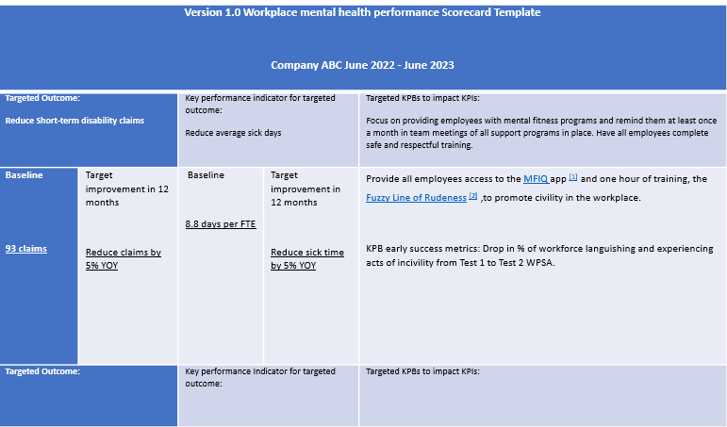Building your workplace mental health performance scorecard
Most employers recognize that creating a psychologically safe and inclusive workplace is essential to protect employees’ mental and physical health and optimize performance. However, figuring out where to start and feeling confident that you’re investing in the right programs and activities can be challenging.
USE THE PLAN-DO-CHECK-ACT APPROACH TO OPTIMIZE RESULTS
The Mental Harm Prevention Roadmap micro-site is a great resource to help you get started. It explains how to create a workplace mental health game plan to reduce mental harm and promote mental health regardless of your organization’s size or resources. The site discusses the Plan-Do-Check-Act (PDCA) approach, which is rooted in continuous learning and improvement and offers a solid foundation for your strategy. Implementing PDCA provides the structure and insights you need to plan, implement and evaluate the impact of your activities and investments.
Plan – Identify problems/challenges/opportunities
Do – Implement solutions
Check – Assess results
Act – Continue with efforts and investments that are providing desired results and stop those that aren’t
TIPS FOR BUILDING A WORKPLACE MENTAL HEALTH PERFORMANCE SCORECARD
Consider the energy, time, dollars, and resources you invest in mental health initiatives. Why have you chosen these programs and activities? What are your desired outcomes? A well-built scorecard will help you track and assess whether your investments are achieving the desired results.
When building your scorecard, avoid making it unrealistic or overly ambitious. Adopt a less-is-more mindset and be clear about your target outcomes. Use the following questions to identify evidence-based measures that you can use to assess the Value of Investment (VOI) and Return on Investment (ROI).
1. What are the top two targeted outcomes expected from your workplace mental health initiatives? For example, you may want to:
-
Reduce short-term disability costs related to mental health
-
Decrease turnover and workplace incivility
-
Increase attraction and retention,
-
Boost financial performance per FTE
When you’ve decided what to focus on, establish a benchmark for each target improvement.
2. What are one or two key performance indicators (KPIs) for each targeted outcome?
Make sure you identify the appropriate KPI to suit your desired outcome. KPIs help ensure that your strategy is being implemented effectively. There are often obvious and less apparent indicators that you can use. For example, if you want to reduce the short term disability claims you’re experiencing, you may track sick time, but bullying and harassment complaints might also be important to watch. These often lead to stress and mental harm, and, in turn, can increase the risk of lost time.
3. What key performance behaviours (KPBs) will directly impact your KPIs and targeted outcomes?
When you’re identifying KPBs, consider behaviours that can have a positive impact when they become habits. You may want to engage employees in focus groups to solicit their input.
Collect data to inform initial planning and monitor whether you’ve selected appropriate KPBs. With the correct data, you can ensure the behaviours you’ve identified drive your KPIs and targeted outcomes.
Need help gathering data, assessing gaps and building impactful programs? Visit the Workplace Safety & Prevention Services (WSPS) Mental Health Consulting page to learn more about how WSPS mental health consultants can help you achieve your goals.
MAKE SURE YOUR INVESTMENT AND EFFORTS ARE HAVING THE DESIRED IMPACT
It’s not uncommon for organizations to track activity-based results, but these are superficial and don’t provide the rich insights you need to understand if your money and time are well spent. For example, reporting to your CEO that 90% of leaders have taken one day of training in the last 12 months may sound good, but you need to assess outcome-based results to understand the impact of your efforts.
The PDCA approach provides the insights and evidence to assess what is working and what’s not and determine whether your programs have the desired impact.
Below is a sample scorecard that illustrates how you can pull all of this information together. Using the Workplace Psychological Safety Assessment (WPSA), Company ABC found that 65% of its workforce is languishing, and 85% has been exposed to acts of incivility (rudeness) in the past 12 months. Following is an example of a scorecard this organization could use to track and report results.
Note: Complete one row for each targeted outcome.

[2] https://vimeo.com/613779096
Your scorecard doesn’t have to be complicated. It just has to give you an accurate picture of what’s working and what’s not. As the saying goes, “What gets measured gets done.” Building a scorecard is an essential step in aligning activities and ensuring that the time, money, and effort you’re investing are having the intended impact on employee health and well-being and organizational performance.
Get to know the author – Dr. Bill Howatt





